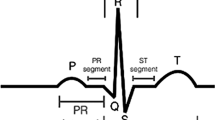Abstract
The technological progress of wireless communication, embedded systems and health offers innovative alternatives to medical care, in particular, telemonitoring and telediagnosis. ECG signal monitoring is a vital indicator in the control of heart disease. Nevertheless, one of the main challenges of remote monitoring of heart rate is the requirement of control in accordance with the service provided by hospital equipment. In this article, an approach to ECG telemonitoring based on wireless sensor networks combined with the Internet of Things (IoT) is proposed. The ECG signal is measured using a wearable sensor node allowing high-frequency noise suppression. The collected data is transmitted to the Gateway node, which performs complex processing including baseline and linear variations suppression using polynomial interpolation, extraction of R peaks using the Multilayer Perceptron Neural Network. It can determine the variation in heart rate by the using the extracted R signal. Thanks to IoT technology, the Gateway node is able to aggregate data into an IoT platform through an IoT cloud for visual telemonitoring of heart rate in real-time. The experimental results show that the system is effective and reliable for the collection, transmission, and display of ECG data in real time for the purpose of telemonitoring of patients with heart disease.





















Similar content being viewed by others
References
Venkatesan, C., Karthigaikumar, P., & Satheeskumaran, S. (2018). Mobile cloud computing for ECG telemonitoring and real-time coronary heart disease risk detection. Biomedical Signal Processing and Control, 44, 138–145.
Abidi, B., Jilbab, A., & El Haziti, M. (2017). A new generation of wireless sensors networks: Wireless body area networks. In Á. Rocha, A. M. Correia, H. Adeli, L. P. Reis, & S. Costanzo (Eds.), Recent advances in information systems and technologies (Vol. 570, pp. 384–393). Cham: Springer International Publishing.
Rapin, M., et al. (2019). Wearable sensors for frequency-multiplexed EIT and multilead ECG data acquisition. IEEE Transactions on Biomedical Engineering, 66(3), 810–820.
Chou, C.-Y., Chang, E.-J., Li, H.-T., & Wu, A.-Y. (2018). Low-complexity privacy-preserving compressive analysis using subspace-based dictionary for ECG telemonitoring system. IEEE Transactions on Biomedical Circuits and Systems, 12(4), 801–811.
Ouelli, A., Elhadadi, B., & Bouikhalene, B. (2014). Multivariate autoregressive modeling for cardiac arrhythmia classification using multilayer perceptron neural networks. In 2014 international conference on multimedia computing and systems (ICMCS), Marrakech, Morocco (pp. 402–406).
Baba, E., Jilbab, A., & Hammouch, A. (2018). A health remote monitoring application based on wireless body area networks. In 2018 international conference on intelligent systems and computer vision (ISCV), Fez (pp. 1–4).
Winkler, S., et al. (2011). Diagnostic accuracy of a new detection algorithm for atrial fibrillation in cardiac telemonitoring with portable electrocardiogram devices. Journal of Electrocardiology, 44(4), 460–464.
Chan, A. M., Selvaraj, N., Ferdosi, N., & Narasimhan, R. (2013). Wireless patch sensor for remote monitoring of heart rate, respiration, activity, and falls. In 35th annual international conference of the IEEE engineering in medicine and biology society (EMBC), Osaka (pp. 6115–6118).
Bakul, G., Singh, D., & Kim, D. (2011). Optimized WSN for ECG monitoring in ubiquitous healthcare system, p. 4.
Spano, E., Di Pascoli, S., & Iannaccone, G. (2016). Low-power wearable ECG monitoring system for multiple-patient remote monitoring. IEEE Sensors Journal, 16(13), 5452–5462.
Lalos, A. S., Alonso, L., & Verikoukis, C. (2014). Model based compressed sensing reconstruction algorithms for ECG telemonitoring in WBANs. Digital Signal Processing, 35, 105–116.
Eraqi, H. MLP neural network with backpropagation—File exchange—MATLAB central. Retrieved June 21, 2019, from https://fr.mathworks.com/atlabcentral/fileexchange/54076.
Poungponsri, S., & Yu, X.-H. (2013). An adaptive filtering approach for electrocardiogram (ECG) signal noise reduction using neural networks. Neurocomputing, 117, 206–213.
N. SEMICONDUCTOR. (2007). nRF24L01 single chip 2.4 GHz transceiver product specification.
González, F., Villegas, O., Ramírez, D., Sánchez, V., & Domínguez, H. (2014). Smart multi-level tool for remote patient monitoring based on a wireless sensor network and mobile augmented reality. Sensors, 14(9), 17212–17234.
Goldberger, A. L., Goldberger, Z. D., & Shvilkin, A. (2018). Bradycardias and tachycardias in Goldberger’s clinical electrocardiography (pp. 194–210). Amsterdam: Elsevier.
Wang, Y., Wunderlich, R., & Heinen, S. (2013). Design and evaluation of a novel wireless reconstructed 3-lead ECG monitoring system. In IEEE biomedical circuits and systems conference (BioCAS). Rotterdam, Netherlands (pp. 362–365).
thingsboard. ThingsBoard—Open-source IoT platform. ThingsBoard. Retrieved June 21, 2019, from https://thingsboard.io/.
Moody, G. B., & Mark, R. G. (2001). The impact of the MIT-BIH arrhythmia database. IEEE Engineering in Medicine and Biology Magazine, 20(3), 45–50.
Pi, R. (2016). Raspberry Pi Compute Module (CM1) Raspberry Pi Compute Module 3 (CM3) Raspberry Pi Compute Module 3 Lite (CM3L).
Goldberger, A. L., et al. (2000). PhysioBank, PhysioToolkit, and PhysioNet: Components of a new research resource for complex physiologic signals. Circulation, 101(23), E215–220.
Stoica, P., & Moses, R. L. (2005). Spectral analysis of signals. Upper Saddle River, NJ: Prentice Hall.
Author information
Authors and Affiliations
Corresponding author
Additional information
Publisher's Note
Springer Nature remains neutral with regard to jurisdictional claims in published maps and institutional affiliations.
Rights and permissions
About this article
Cite this article
El Attaoui, A., Hazmi, M., Jilbab, A. et al. Wearable Wireless Sensors Network for ECG Telemonitoring Using Neural Network for Features Extraction. Wireless Pers Commun 111, 1955–1976 (2020). https://doi.org/10.1007/s11277-019-06967-x
Published:
Issue Date:
DOI: https://doi.org/10.1007/s11277-019-06967-x




